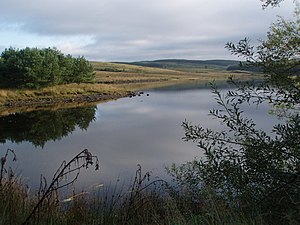Lochinvar
| Lochinvar | ||
|---|---|---|

|
||
| The north-west bank of Lochinvar | ||
| Geographical location | Dumfries and Galloway , Scotland | |
| Drain | Lochinvar Burn → Water of Ken → Dee | |
| Data | ||
| Coordinates | 55 ° 8 '34 " N , 4 ° 6' 21" W | |
|
|
||
| length | 1 km | |
| width | 500 m | |
Lochinvar is the name of an approximately 1000 × 500 meter large lake in Scotland , which is located in the administrative district of Dumfries and Galloway five kilometers northeast of the city of St John's Town of Dalry . From the Lochinvar feeds the Lochinvar Burn , which flows south into the River Water of Ken .
The name Lochinvar comes from the Scottish Gaelic language , in which it would mean Loch an barr . It means lake on the mountain top . The Lochinvar was eponymous for the aristocratic title Baron of Lochinvar and Laird of Lochinvar .
Todays use
In the 1960s the lake was dammed as part of a hydropower project; There is also a small power station there. Due to the rising water level, the small island in the middle of the Lochinvar was flooded, so that the ruins of the former fortress of the Gordons of Lochinvar standing there can no longer be seen.
A small pyramid built from the stones of the ruin reminds of the fortress today with the following inscription: “Lochinvar. Water level raised in 1968. An island that is now under water was the site of a ruin. Their stones were used to build this stone pyramid ”( Lochinvar. Level raised 1968. An island now submerged was the site of a ruin. Stones from which have been used to build this cairn ).
Young Lochinvar as a literary figure
Lochinvar or Young Lochinvar is the title character of a poem from the epic Marmion by Sir Walter Scott about the Battle of Flodden in 1513 between a winless Scottish invasion army and the English crown under James IV. , Whose personality way into British English slang found Has. The poem depicts the hero of the poem in a typical Scottish narrative form: Medieval motifs are mixed in romantic distancing and irony.
The name has remained alive as an idiomatic phrase in British English for “carefree hero” or “knight in shining armor” and is thus comparable to “ Rasenden Roland ” ( Orlando Furioso ) in literary history .
See also
- Lochinvar National Park in Zambia
